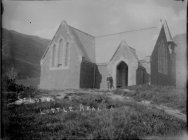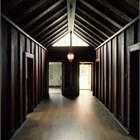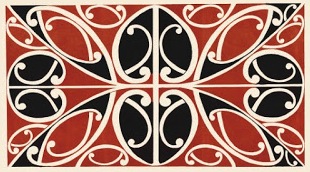John Henry Menzies was born in 1839 in Liverpool of scottish descent. He arrived in New Zealand in December 1860, as an energetic young man of 20 or 21 already imbued with strong views (he never touched alcohol again, having seen young men wasting their time drinking and playing cards on the voyage out). He already had some skill in wood carving, honed in his schooldays at Cheam, where he found that carving paper knives, boats and spoons for putting grease on the hair earned him protection from the big boys - though he seems to have been able to defend himself with his fists too. He had grown up in the countryside around Manchester, the son of a businessman with an interest in farming and a strictly religious mother.
On leaving school he spent a year at Edinburgh University followed by an unsuccessful period as an insurance clerk in an uncle's firm. During this phase he enjoyed outdoor activities -botany field trips, walking tours with his brothers around Liverpool and Ireland- and was taken on a tour of Europe by his father. Finally, he says in his Family History, "my father at last came to the conclusion that I had better go to New Zealand". Before he sailed, he spent a period with a well-to-do farmer in Yorkshire, near his mother's family, who also had a business as a tenant right valuer. Going round various sorts of land with the shrewd Mr Simpson gave young John Henry a good preparation for his land purchase and development in New Zealand.
Once in New Zealand, he settled first in Southland, where he bought, developed and sold land at Ryal Bush, Spar Bush, and finally near Riverton, a 4000 acre property near Otautau, which was then called Ringway after his family's farm.
In 1865 he married Frances Elizabeth Butler. She had settled with her family at Ryal Bush in 1862.
In 1878, Menzies and his wife decided to move further north. On 12 September 1878, the family arrived at McIntosh Bay on Banks Peninsula (Horomaka). He bought the land from Tom McIntosch, and built in the place of his simple cottage in 1879 the homestead "Glen Mona". It was elaboratively decorated with carvings of Maori patterns and flower motifs. The bay was renamed to Menzies Bay.
Menzies put his usual energy into developing the property (about 4,400 acres), and three more children were born. Friends visited frequently. One of these was young Georgie Robinson, who much later (1953) wrote to a friend an account of how Menzies revived his old carving skills:
"It was a foggy, drizzly time and for indoor amusements fret-saw
became the rage, and Mr Menzies was drawn in by the urge to make the
flat leaves or flowers of the patterns more life-like, so he cut veins
and marks on them. But that, being flat, was not satisfactory and he
took a bit of wood and carved the shapes and added all that nature
wrote on them. This enthralled him, he bought a great bureau, stocked
it with all tools, and sat before the largest window, and carved
everything. The stair rails, the picture frames, table tops or edges,
the trays, etc. Having finished his house he began to agitate for a
Church in the next bay where a proper service could be held, not just
a schoolroom, and a lay-reader once a month. This, in stone, he carved
St Lukes church in Little Akaloa on Banks
Peninsula with wood carvings
also, those Maori patterns he studied deeply and felt that he had got
an inkling of what they stood for. When his daughters married (Connie
and Charlotte) he carved much of their houses too."



Photo at left by J D Richardson (on glass; unknown date);
from the
"Sir George Grey Special Collections, Auckland Libraries, 4-6811".
The photos of details (at right) are by
Kevin Jelley (see there for more).
The church building became St Luke's Church in Little Akaloa,
in which both stone and wood were carved in Maori patterns.
Menzies lived on site near the church during most of the construction
period which began in March 1905 and as a result of his efforts the
church was completed free of debt and was consecrated on 6 December 1906.
He designed the bulding and did the carving for the interior,
for the font and the desk.
The bell tower of St Luke's commemorates William Menzies' wife
Gertrude and the bell commemorates Reverend Canon Frederick Menzies.
St Luke's Church demonstrates the faith and commitment shared by
the residents of Little Akaloa and Menzies Bay.
It is a monument to the memory of J.H. Menzies and is the realisation
of this Pakeha's fascination with Maori decorative art.
It is the earliest known example of a Pakeha designer
using Maori decorative motifs for a Pakeha congregation.

|
One of the houses built and carved by Menzies survives. It is Rehutai, in Menzies Bay, built for his son William (and his wife Gertrude) at Menzies Bay in 1894. The photo at left shows its interior.

|

|
He also made a book with painted Maori patterns (Menzies, 1904) resulting from his study of Maori artefacts held in the Canterbury Museum.

|
A number of pieces of carved furniture, mostly but not entirely in Maori patterns, are still held by his descendants.
The house Glen Mona burned down in 1907. Its replacement was similarly decorated. (Unfortunately, the replacement was also destroyed by a fire in 1929; thus the Rehutai house is the only example left of J.H.Menzies' understanding of Maori art.)
References:
Family History to 1877, by J H Menzies. First
published privately by J.H. Menzies, undated; republished by the
Menzies family in 2004; many illustration by his own hand.
J.H. Menzies, 1904. "Maori Patterns Painted and Carved"
The Story of Menzies Bay, by Ian H Menzies. Privately published, 1970
The Recollections of Frances Elizabeth Menzies, compiled by Janet Hector. Published by the Menzies family, 2004.
The Diary of Frances Elizabeth Menzies. Published by the Menzies family, 2003.
The European Use of Maori Art in New Zealand
Homes, c.1890-1914, by Anna K.C. Petersen. In Barbara Brookes (ed.),
At Home in New Zealand: History Houses People; Bridget Williams Books, 2000.
Note: Books published by the Menzies family can be obtained from P and J Hector, 1 Mahina Road, Mahina Bay, Eastbourne, Wellington.
The text above was in 2005 prepared by Janet Hector
(for Neil
Pardington).
Small adjustments were made by KSdB, including a few additions
(especially images).
About St Lukes see also Historic Society
Back to the lives of JHM and FEB.
Back to the genealogy of JHM and FEB.